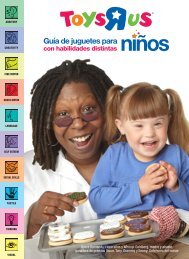English
English
English
Create successful ePaper yourself
Turn your PDF publications into a flip-book with our unique Google optimized e-Paper software.
Safe Play Tips for Children with Special Needs<br />
4<br />
Safe Play Tips for<br />
Children with Special Needs<br />
These tips were created by Toys“R”Us, Inc. with guidance<br />
from leading safety and special needs organizations<br />
Through the magic of play, all children can experience victories, imagine new worlds and share the joy of<br />
learning. But accidents can happen and rates of accidental injury are higher among children with special<br />
needs. This includes children who have physical and psychological disabilities and is especially true for<br />
children who have cognitive, emotional and social limitations.<br />
While basic safety rules apply to all children, regardless of ability, the delivery of the message should be<br />
tailored to ensure that a child who has a disability truly understands and internalizes how to play safely.<br />
To make sure playtime is a positive, memorable learning experience for your child, following is a list of<br />
tips to help minimize playtime risks among children with special needs:<br />
• Never Leave a Child Unsupervised: It is especially critical that a child with special needs is<br />
properly supervised by an adult or trusted caregiver at all times.<br />
• Read Labels for Ability: Check toy packages for age grading but choose toys that correspond<br />
with a child’s learning level rather than merely matching a toy with his/her actual age.<br />
Toys that are misused or inappropriate for a child’s particular abilities can pose a risk of injury.<br />
• Survey the Play Area: Designate a specific area of the home for regular playtime, one void of<br />
hazards such as electrical wires across the floor that a child could trip over, hanging cords that<br />
could cause strangulation and pools or windows that a child could fall in/through. Safety gates or<br />
other barriers can also be helpful in keeping children away from areas unfit for their age or abilities.<br />
• Establish Concrete Rules: Before playtime begins, discuss basic guidelines about what areas are<br />
off limits (i.e., the street, roof or pool). Make the message clear by saying, “Never go past this line<br />
without Mommy” and “Yell, HELP! if you are hurt, lost or scared.”<br />
• Use Visual Warnings: Post notes with phrases, such as, “Don’t Touch!” and “Off Limits!” on toys<br />
for older children, as well as power tools, the stove, kitchen drawers or any other potential source<br />
of injury; doing so can help a child who has developmental challenges distinguish between an<br />
appropriate toy and an object that may be dangerous.<br />
• Review and Repeat: After setting playtime rules, create visual reminders to post somewhere in<br />
the house or play area to serve as a constant reminder to the child. Also, ensure a child grasps the<br />
message by prompting him/her with hypothetical situations such as, “What do you do when a ball<br />
rolls into the street?” and “What could happen if you play near the pool?”<br />
• Prepare for Off-Site Play Dates: When scheduling a play date out of the home, pack a First Aid kit<br />
for the guardian to carry and a Child ID package to put in the child’s pocket or backpack, inclusive<br />
of the child and parent/guardian’s name, and emergency contact information and instructions<br />
(i.e. allergies, illnesses/disabilities and medicinal protocol).<br />
• Safe Storage: Teach children to put toys away so they do not pose a tripping hazard. Store an<br />
older child’s toys in a separate storage bin and regularly check for toys that may become worn,<br />
damaged or have missing parts.<br />
• Avoid Trigger Toys: For children who are prone to seizures, it’s best to avoid spinning or flashing<br />
toys. Opt for toys that have volume control for children who are adversely affected by loud noises.<br />
And make sure children have the postural stability to utilize ride-on vehicles and wagons.



